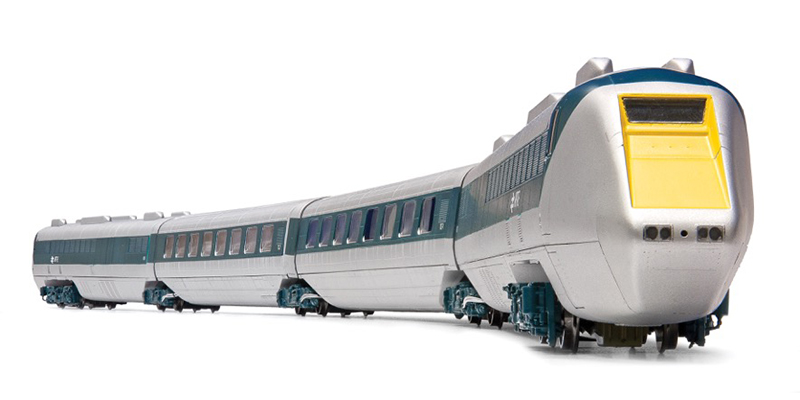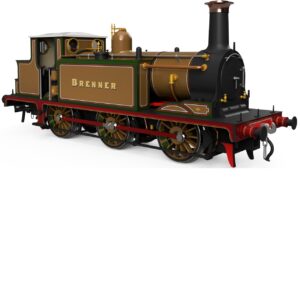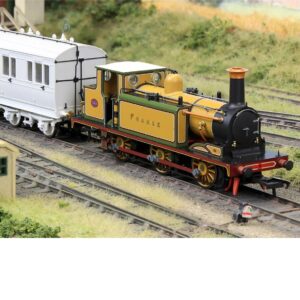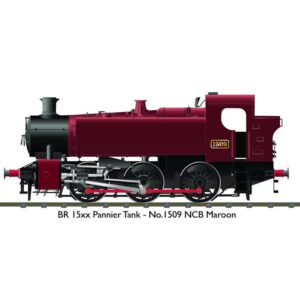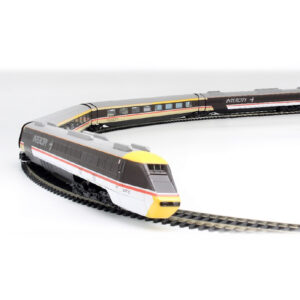We’re absolutely delighted to announce that the ‘OO’ gauge APT-E is back! Originally produced as part of the National Collection In Miniature range, the National Railway Museum has given us permission to produce this batch as a standalone Rapido Trains UK product.
In the late 1960s, British Rail found itself with two very successful 100mph high speed trains: English Electric ‘Deltics’ on the East Coast Main line and the ‘AL6’ 25kV electrics
Elsewhere, however, BR was faced with the difficulty of increasing speed on existing lines which were often tightly curved and steeply graded. A solution was needed which would allow high speed operation on these lines and the search led to the development of the Advanced Passenger Train.
The APT-Experimental was a test bed for new ideas. It incorporated lightweight construction, high power/weight ratio, good aerodynamics, improved braking and an innovative tilt system that would allow high speed operation on existing curves while maintaining both safety and customer comfort. The train consisted of four units – two power cars and two intermediate cars.
The power cars each contained five British Leyland turbines that been originally developed for use in lorries. These turbines were originally rated at 300bhp each, later increased to 350bhp. The turbines drove an alternator which provided power for two traction motors. One of the intermediate cars was fitted with a passenger compartment, the other was stuffed full of instrumentation and electrical gear to allow the travelling engineers to monitor the various systems on the train. A diesel generator fitted in both power cars provided accessory power to provide all of the electrical power needed for these instruments
APT-E was tested extensively between June 1972 and April 1976 logging nearly 23,600 miles. On August 10 1975, the APT-E achieved the British railway speed record of 152.3mph during trials on the Great Western Main Line. This record still stands for non-electrified rail travel in the UK. Following its test period, the APT-E test train was donated to the National Railway Museum in York. Thanks to the efforts of the APT-E Conservation and Support Group it has been restored visually to the appearance that it had during its testing period. This unique train can be seen today at the NRM’s Locomotion Museum at Shildon.

The APT-E was Rapido’s first British-outline project. It was launched in 2014 and the final production models were delivered to eager customers in spring 2016. The model was designed with input from members of the original APT-E development and conservation teams, as well as state-of-the-art laser 3D scanning techniques and CAD work.
Featuring a working tilt system and full interior instrumentation, the ‘OO’ gauge APT-E model has been praised by customers and in the model press as every bit as revolutionary as the real thing – so much so it came second in Model Rail’s Model of the Year in the diesel and electric category and has been regularly asked to be produced as a second run by modellers.
The APT-E model will again be produced in two versions, with factory-fitted DCC and a custom ESU LokSound sound decoder, or as a DCC-ready analogue model. Headlights and tail-lights in the power cars are fully operational and directional. Additional passenger-equipped trailing cars will also be available for those wishing to operate a longer train as it may have appeared in service.
Specifications:
? Two Power Cars each with a five-pole, skew-wound motor
? Two Trailer Cars with articulated Swinging Arm Trailer Bogies
? 3D scanned exterior for accurate body contours.
? Operating tilt mechanism and close coupling system
? Operates smoothly down to Radius 2 (438mm) curves
? Full interior detail including illuminated test instrumentation.
? Working headlamps, tail lamps and interior lighting
? Conventional DC or factory fitted with ESU DCC sound decoder
? Accurate sound recorded from archival footage
? Smooth-running mechanism with dual motors and flywheels
? Designed for drop-in conversion to ‘P4’ and ‘EM’ gauges




